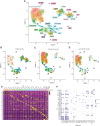Single-Cell RNA Sequencing of Urinary Cells Reveals Distinct Cellular Diversity in COVID-19-Associated AKI
- PMID: 35368565
- PMCID: PMC8967619
- DOI: 10.34067/KID.0005522021
Single-Cell RNA Sequencing of Urinary Cells Reveals Distinct Cellular Diversity in COVID-19-Associated AKI
Abstract
Background: AKI is a common sequela of infection with SARS-CoV-2 and contributes to the severity and mortality from COVID-19. Here, we tested the hypothesis that kidney alterations induced by COVID-19-associated AKI could be detected in cells collected from urine.
Methods: We performed single-cell RNA sequencing (scRNAseq) on cells recovered from the urine of eight hospitalized patients with COVID-19 with (n=5) or without AKI (n=3) as well as four patients with non-COVID-19 AKI (n=4) to assess differences in cellular composition and gene expression during AKI.
Results: Analysis of 30,076 cells revealed a diverse array of cell types, most of which were kidney, urothelial, and immune cells. Pathway analysis of tubular cells from patients with AKI showed enrichment of transcripts associated with damage-related pathways compared with those without AKI. ACE2 and TMPRSS2 expression was highest in urothelial cells among cell types recovered. Notably, in one patient, we detected SARS-CoV-2 viral RNA in urothelial cells. These same cells were enriched for transcripts associated with antiviral and anti-inflammatory pathways.
Conclusions: We successfully performed scRNAseq on urinary sediment from hospitalized patients with COVID-19 to noninvasively study cellular alterations associated with AKI and established a dataset that includes both injured and uninjured kidney cells. Additionally, we provide preliminary evidence of direct infection of urinary bladder cells by SARS-CoV-2. The urinary sediment contains a wealth of information and is a useful resource for studying the pathophysiology and cellular alterations that occur in kidney diseases.
Keywords: COVID-19; SARS-CoV-2; acute kidney injury; acute kidney injury and ICU nephrology; basic science; single-cell RNA sequencing; urine.
Copyright © 2022 by the American Society of Nephrology.
Conflict of interest statement
A. Agarwal reports consultancy agreements with Akebia Therapeutics (served on an expert panel to review new therapeutics on the basis of the hypoxia-inducible factor pathway for AKI), Dynamed (reviewed content related to AKI for Dynamed and reviewed and updated materials prepared by the Dynamed editorial team for AKI topics), and Reata Pharmaceuticals (served as a consultant); ownership interest in Goldilocks Therapeutics, Inc.; research funding from the Genzyme/Sanofi Fabry fellowship award; and honoraria from Akebia Therapeutics, Emory, the University of Southern California, and Vanderbilt. A. Agarwal also reports scientific advisor or membership as an editorial board member for American Journal of Physiology–Renal Physiology, Kidney International, and Laboratory Investigation; as an advisory board member of Goldilocks Therapeutics, Inc. (a New York–based company investigating the delivery of drugs in the kidney using nanotechnology for acute kidney disease and CKD); as an external evaluation panel member for the Kidney Precision Medicine Program; and as an advisory board member of Alpha Young, LLC and Angion. All remaining authors have nothing to disclose.
Figures




References
-
- Batlle D, Soler MJ, Sparks MA, Hiremath S, South AM, Welling PA, Swaminathan S; COVID-19 and ACE2 in Cardiovascular, Lung, and Kidney Working Group : Acute kidney injury in COVID-19: Emerging evidence of a distinct pathophysiology. J Am Soc Nephrol 31: 1380–1383, 2020. 10.1681/ASN.2020040419 - DOI - PMC - PubMed
-
- Xia P, Wen Y, Duan Y, Su H, Cao W, Xiao M, Ma J, Zhou Y, Chen G, Jiang W, Wu H, Hu Y, Xu S, Cai H, Liu Z, Zhou X, Du B, Wang J, Li T, Yan X, Chen L, Liang Z, Zhang S, Zhang C, Qin Y, Wang G, Li X: Clinicopathological features and outcomes of acute kidney injury in critically ill COVID-19 with prolonged disease course: A retrospective cohort. J Am Soc Nephrol 31: 2205–2221, 2020. 10.1681/ASN.2020040426 - DOI - PMC - PubMed
-
- Teoh JY-C, Yip TC-F, Lui GC-Y, Wong VW-S, Chow VC-Y, Ho TH-Y, Li TC-M, Tse Y-K, Chiu PK-F, Ng C-F, Hui DS-C, Chan HL-Y, Szeto C-C, Wong GL-H: Risks of AKI and major adverse clinical outcomes in patients with severe acute respiratory syndrome or coronavirus disease 2019. J Am Soc Nephrol 32: 961–971, 2021. 10.1681/ASN.2020071097 - DOI - PMC - PubMed
-
- Richardson S, Hirsch JS, Narasimhan M, Crawford JM, McGinn T, Davidson KW, Barnaby DP, Becker LB, Chelico JD, Cohen SL, Cookingham J, Coppa K, Diefenbach MA, Dominello AJ, Duer-Hefele J, Falzon L, Gitlin J, Hajizadeh N, Harvin TG, Hirschwerk DA, Kim EJ, Kozel ZM, Marrast LM, Mogavero JN, Osorio GA, Qiu M, Zanos TP; the Northwell COVID-19 Research Consortium : Presenting characteristics, comorbidities, and outcomes among 5700 patients hospitalized with COVID-19 in the New York City area. JAMA 323: 2052–2059, 2020. 10.1001/jama.2020.6775 - DOI - PMC - PubMed
Publication types
MeSH terms
Grants and funding
LinkOut - more resources
Full Text Sources
Medical
Molecular Biology Databases
Miscellaneous

